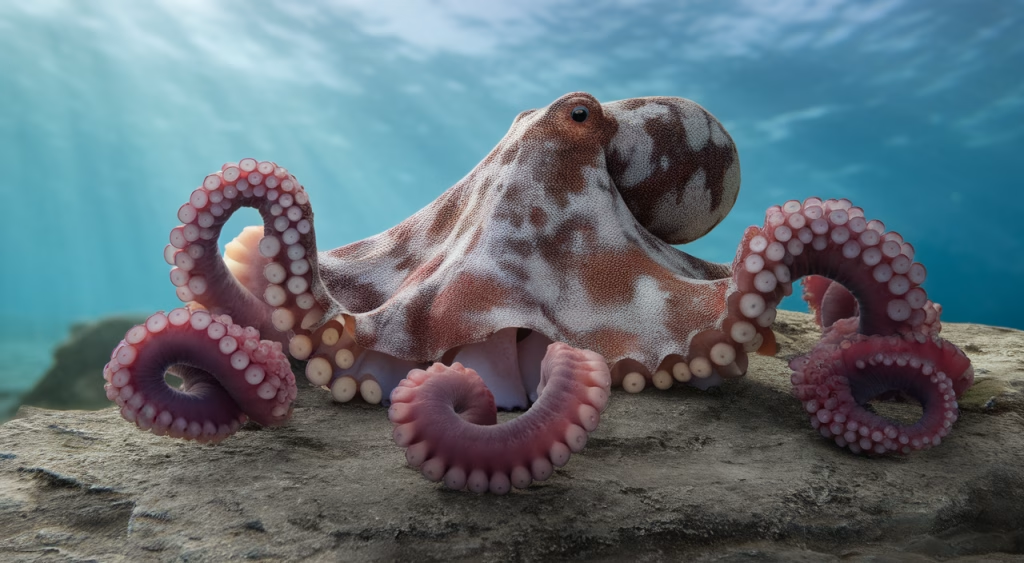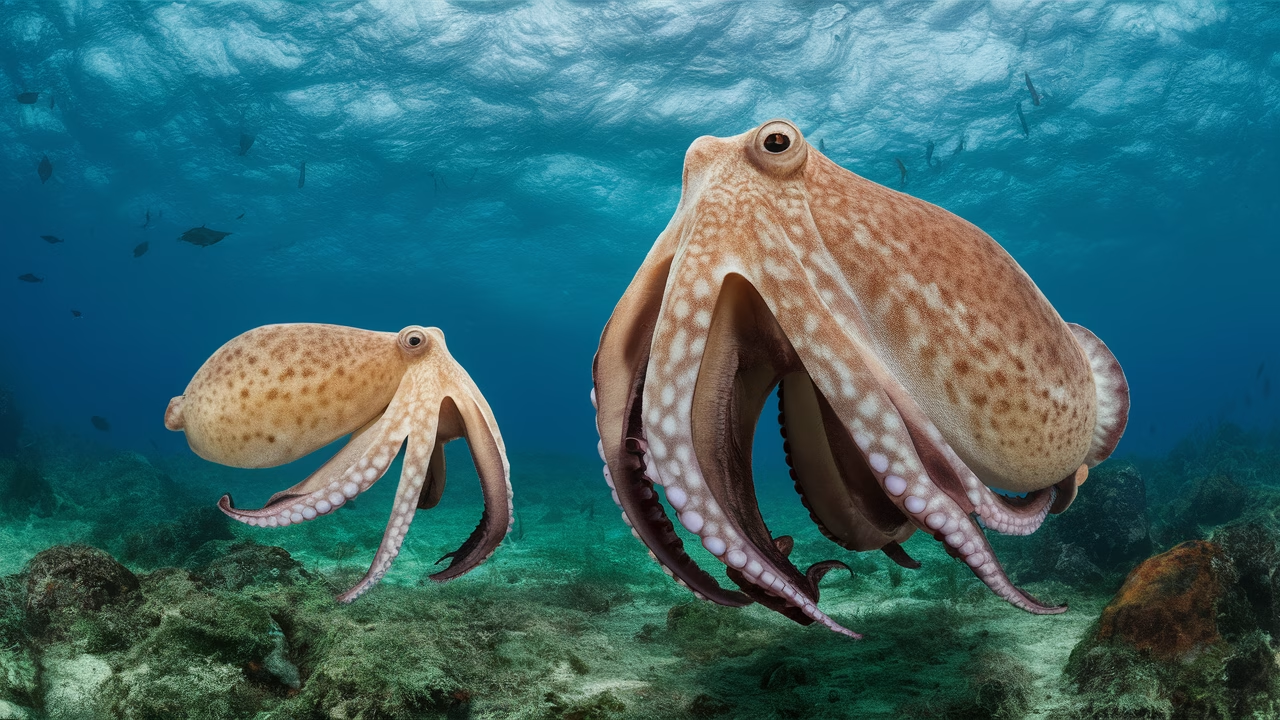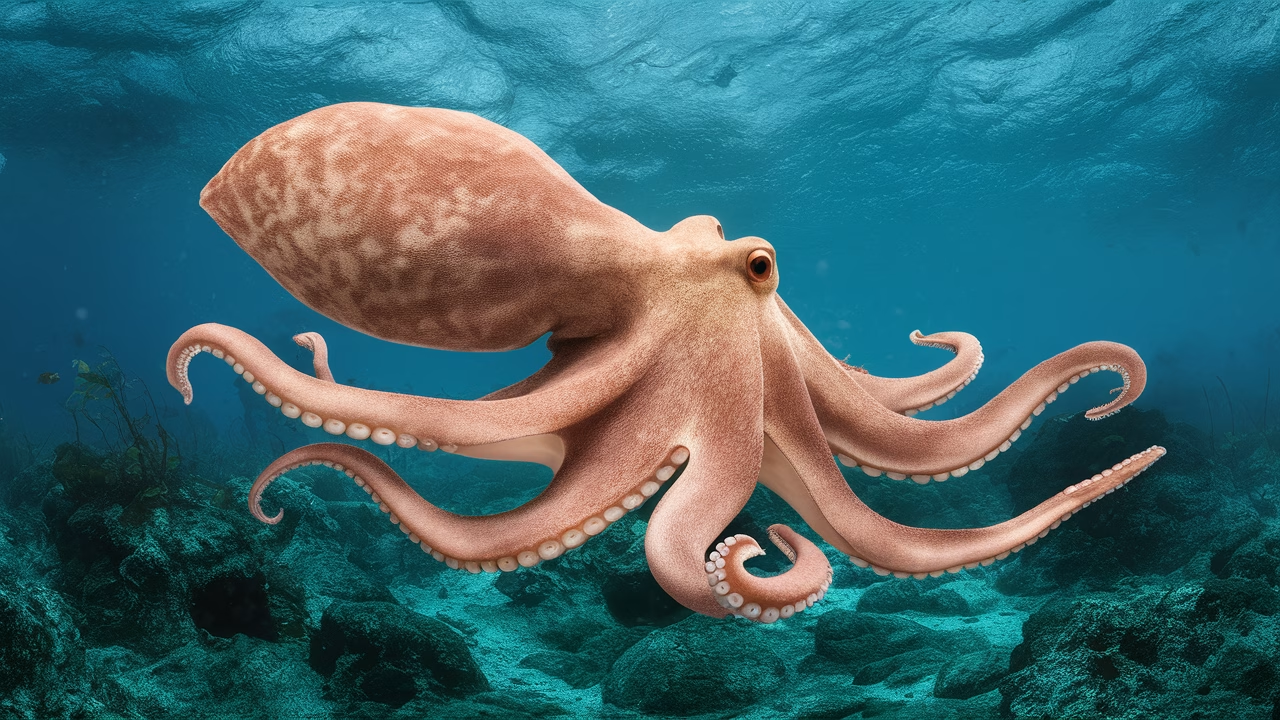Why is the male blanket octopus 40,000 times smaller than the female?
The male blanket octopus size difference exists because of one of the most extreme examples of sexual dimorphism in the animal kingdom. Males remain tiny to adapt to a parasitic-mating lifestyle, whereas females grow large to maximize reproductive success and fend off predators in the open ocean.
TL;DR: Male vs Female Blanket Octopus Size Difference
- Size disparity: Males average about 2–3 cm long, while females can grow up to 2 meters—roughly 40,000 times larger by mass.
- Biology behind the size: The difference is evolutionary, rooted in reproductive roles and environmental adaptation in tropical oceans.
- Fascinating fact: Males use modified tentacles (hectocotylus) to mate, detaching them inside the female and dying afterward. They’re built for a single purpose.
- Where they live: Found in the epipelagic zone of warm ocean waters, draped in bioluminescent, web-like tissue.
- Biology and anatomy insights: Features like the female’s defensive ‘blanket’ displays and the absence of it in males reflect the dramatic task division between the sexes.
Introduction to the Blanket Octopus
The blanket octopus is a marvel of marine life—one part mystery, one part spectacle. Floating through the open ocean with swaying sheets of translucent webbing, it resembles a living ghost draped in color. But beyond the aesthetics lies a tale of surprise: the male blanket octopus size reaches just 2 to 3 cm long, barely larger than a paperclip. Female blanket octopus size? They’re towering giants by comparison, reaching 2 meters or more in length, and outweighing the males by up to 40,000 times. Let that sink in—this isn’t just blanket octopus biology; it’s high-stakes survival theater showcasing the most extreme octopus anatomy differences in nature.
Biology of the Blanket Octopus
Blanket Octopus Biology and Evolution
Blanket octopuses (genus Tremoctopus) inhabit warm, open oceans across the world. They belong to the pelagic zone—far from reefs and sea floors—where visibility, predators, and prey shape how an animal must evolve to survive. In this deep blue realm, the blanket octopus has emerged as a floating fortress, especially in the case of females.
From a blanket octopus biology standpoint, the vast size difference is a function of sexual dimorphism—a survival trait where one sex (female) accumulates traits like size and defensive tools to ensure egg-laying success, while the other sex (male) becomes disposable post-reproduction. Males are sperm carriers, and once they have delivered their precious package (via a specialized reproductive arm), their work—and indeed, life—is complete.
Blanket Octopus Anatomy and Biology
Let’s examine key parts of their octopus anatomy and physiology to understand how this male vs female blanket octopus disparity works:
- Web-like blanket: Only females have the spectacular, flowing webbing between their arms—used to intimidate predators and as a defense display.
- Hectocotylus arm: Males have one specially adapted arm for reproduction. It contains sperm packets and detaches inside the female during mating.
- No ink sac: Unlike many octopus species, blanket octopuses lack an ink sac—an adaptation to pelagic ocean life where speed and stealth are favored.
- Bioluminescence: Some species may exhibit bioluminescence to confuse predators and attract mates.
| Feature | Male Blanket Octopus | Female Blanket Octopus |
|---|---|---|
| Average Size | 2–3 cm | 1–2 meters |
| Defense Mechanism | Steals jellyfish tentacles to sting predators | Unfurls massive web-like blanket |
| Reproductive Role | Dies after transferring sperm | Lays eggs and protects them |
Male vs Female Blanket Octopuses
Comparing Sizes and Adaptations
The comparison of “male vs female blanket octopus” isn’t a simple size difference—it’s a study in evolutionary extremes. Where else in the animal kingdom does one sex dominate in both size and spectacle while the other perfects miniaturization?
Let’s examine male blanket octopus size: these miniature creatures weigh less than a paperclip, representing the blanket octopus average size for males. But they don’t need much bulk. Their role is concise—locate a receptive female, transfer their sperm, and fade into biochemical history. Because of their small male blanket octopus size, they consume fewer resources and are quick-moving, avoiding predators with high agility.
On the flip side, female blanket octopus size embodies power and protection in blanket octopus anatomy and biology. Her enormous web-like “blanket” stretches out behind her, adding up to several meters of flowing camouflage that can also be jettisoned to confuse predators. Females can live up to three years, focusing on laying massive clusters of eggs, enclosing them in mucous strings that trail behind her arms as she drifts with the current.
This difference is not accidental; it’s the result of remarkable evolutionary strategy in blanket octopus biology—an example of how different survival and reproductive priorities warp octopus anatomy in opposite directions.
Habitat and Behavior
Subtropical and Tropical Oceans
Blanket octopuses live a pelagic lifestyle—drifting through the warm, open waters of the Indian, Atlantic, and Pacific Oceans. They are rarely seen close to coasts or sea floors, preferring instead the open blue, typically between the surface and upper mesopelagic zone (about 200 meters deep).
This habitat is vast, unstructured, and full of danger. That’s perhaps why blanket octopus biology evolved such dramatic strategies. Without rocks or coral for shelter like reef-dwellers, pelagic octopuses rely on stealth, mimicry, and visual flair. The female’s flowing webbing mimics larger predators or seaweed, while the male—despite his tiny male blanket octopus size—has mastered underdog ingenuity and has been known to use venomous tentacles from Portuguese man-o-wars as weapons.
In both cases, these adaptations in octopus anatomy reflect how form and function are directly shaped by the sea’s wide, open ballet floor.
Conservation Efforts and Conclusion
Protecting the Unique Species
Despite their rarity and beauty, blanket octopuses are not currently classified as endangered. That said, their open-ocean lifestyle makes them sensitive to shifts in climate, pollution, and overfishing—all of which threaten pelagic species in subtle yet profound ways.
From a conservation standpoint, understanding their vast male vs female blanket octopus size discrepancy aids in clarifying their behavior, lifecycles, and environmental needs. More targeted protections for the open-ocean habitat, increased restrictions on plastics, and deep-sea exploration will help illuminate what remains hidden in their life cycles and blanket octopus biology.
So the next time you imagine the deep—think of her, the blanket octopus, trailing silken armor with ethereal grace. And him, the little needle of determination, vanishing into her story forever. They are two sides of the same watery coin—and together, their remarkable size difference tells a tale more dramatic than any fiction could write.
Frequently Asked Questions
- Are male blanket octopuses smaller than females? Yes, astronomically so. The male blanket octopus size is about 40,000 times lighter than females, measuring just 2–3 cm compared to the female’s 2 meters.
- Why is there such a huge size difference? It’s due to sexual dimorphism shaped by evolution in blanket octopus biology. Males need fewer resources and focus solely on mating, while females grow larger for defense and egg-laying.
- Do male blanket octopuses live long? No. Typically, they die shortly after mating, having fulfilled their role despite their small male blanket octopus size.
- What is the blanket on a blanket octopus? It’s a web of tissue between arms found only in females, used as a defense mechanism by mimicking size and confusing predators—a key feature in octopus anatomy.
- Where can they be found? They live in subtropical and tropical pelagic zones of the open ocean, including the Indian, Atlantic, and Pacific.
- Are they dangerous to humans? Not directly. They’re elusive, rarely encountered, and pose no threat regardless of the dramatic female blanket octopus size.
- How do scientists study them? Mostly through deep-sea submersibles, trawling nets, and rare underwater encounters caught on camera to study their blanket octopus anatomy and biology.



